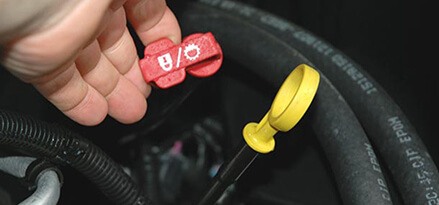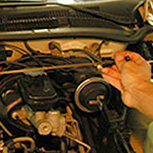By Tom Morr
Vehicles' vital fluids normally perform two important functions: lubricating and cleaning. As the fluid circulates through the parts, it gathers the dirt and metal shavings that can accumulate over time. If you're lucky, this debris will settle on the bottom of the pan or housing and not circulate through the system. That’s why some auto shops use machines that perform a transmission fluid flush, ensuring that more of this debris is removed before any new transmission fluid is poured into the vehicle.
Nothing prolongs vehicle life more than regular fluid changes. In automatic transmissions/transaxles, the recommended service interval is about every 30,000 miles or 30 months. (Check your owner's manual or service manual for your car's specifics.) The automatic transmission fluid (ATF) should be changed sooner if its dipstick reveals dark or burnt-smelling fluid.
DIY transmission fluid and filter changes
Even those of us who change our own oil often cringe at the prospect of draining ATF. Because many transmission pans don't have drain plugs, changing the fluid can be a messy proposition –the entire pan must be removed. But even on vehicles that do have drain plugs, the pan still must be removed to change the filter.
Changing transmission fluid is one of those messy jobs that someone has to do. Doing the deed yourself will save money, possibly time and fresh ATF can make your gearbox perform young beyond its years. It’s also relatively easy to determine when your ATF may be low. Consider an automatic transmission service if you detect the following signs of low transmission fluid:
- Transmission slips
- Transmission shifts roughly
- Noisy transmission
- No drive engagement in forward or reverse gears
How to change automatic transmission fluid: Step-by-step instructions
If you can garner some initial patience, learning how to change automatic transmission fluid will only benefit you in the long run. More importantly, you’ll need an automatic transmission filter kit; they normally contain a gasket for the pan in addition to the new transmission filter and its O-ring. Along with some basic shop tools, you’re ready to get started.
-

Step 1: Transmission fluid drains better at operating temperature, so let your car idle for a few minutes first. After turning your ignition off, raise and secure the vehicle. Then, lay down a tarp, some cardboard or a newspaper under at least a two-gallon catch pan. Next, remove the bolts from one side of the transmission pan, being cautious of hot exhaust parts and fluid.
Always practice good safety behaviors when working on motor vehicles. To help prevent injuries, use appropriate personal protective equipment, which may include safety gloves, goggles, helmets and shoes.










